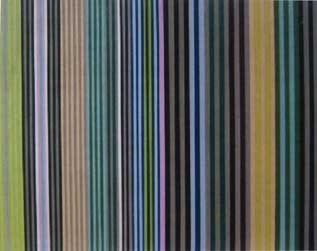
|
||
|
Portland art blog + news + exhibition reviews + galleries + contemporary northwest art
|
||
More PAM Aquisitions  Gene Davis, Angel Fish (1970) The Portland Art Museum has announced yet another acquisition... actually it's a total of 350 acquisitions. The estate of Elvin Duerst has bequested 350 art objects, from an important early Gene Davis, "Angel Fish"... to Spanish colonial, Asian and contemporary Latin American works. Duerst, a McMinnville Oregon native lived in Washington D.C. for the last 65 years having worked for the United Nations, and the State Department. Duerst was intimately connected to the Washington Colorfield school and dovetails nicely with the museum's acquisition of the Greenberg Collection in 2001 (which had many important holes like Morris Louis, Barnett Newman and Gene Davis). Many have remarked that the Greenberg Collection should have ended up in the DC area and now they've got to be wondering how Portland has become such a magnet for 60's and 70's formalism. Let's just say we like abstraction, many of the best selling artists in town deal with formal abstraction and then there is the fact that Mark Rothko grew up here. Posted by Jeff Jahn on February 10, 2007 at 14:12 | Comments (2) Comments The Greenberg Collection was a great acquisition. I am still amazed the museum picked it up. Granted, they aren't the paintings that Clement Greenberg was truly known for collecting, since he sold most of the "big" pieces, but it still is a great collection. And why do we tend to have an affinity for 60's and 70's formalism? And I don't know if Rothko even liked this area. After he left here, when he was still rather young, I don't think he ever came back. Posted by: Calvin Ross Carl Rothko had his first big solo show at the museum as a young man... but no he needed to leave. There was nothing here for an ambitious artist like Rothko in Portland During the 30's and 40's. Back then you had to go to New York. Today it seems like we are being flooded by ex-Brooklyners. Still, I believe Portland's expressive skies and sense of consensed yet vast space had an effect on the man. You can't ignore the sublime in the Northwest (sure the OSP in Seattle tried, but good luck). The formal affinity for color, volume, saturation and space seems inherent in the environment here and that's why formalism or colorfield painting is popular here. Did Rothko like the later colorfield painters? Ha, I doubt it. He was a hypercritical knit-picker, and every time I read his writings its like running into a typical Portland coffee house denizen. If youve been in Portland coffee houses youve met the type... all full of iconoclastic ideas, well read, ridiculous conviction, melancholy and a few perceptive bits. Rothko made that withering kind of philisophical iconoclasm work in his art eventually (but man did he paint some terrible stuff before he found his signature style). Still, I go through local rummage sales looking for his very early landscapes... many of those arent bad. Posted by: Double J Post a comment Thanks for signing in, . Now you can comment. (sign out)
(If you haven't left a comment here before, you may need to be approved by
the site owner before your comment will appear. Until then, it won't appear
on the entry. Thanks for waiting.)
|
| s p o n s o r s |
 |
 |
 |
 |
 |
 |
 |
 |
 |
 |
 |
 |
 |
 |
 |
 |

|
Site Design: Jennifer Armbrust | • | Site Development: Philippe Blanc & Katherine Bovee | |


![[TypeKey Profile Page]](http://www.portlandart.net/nav-commenters.gif)